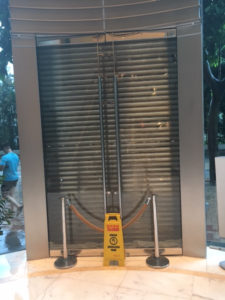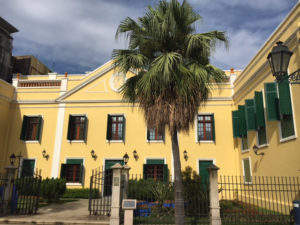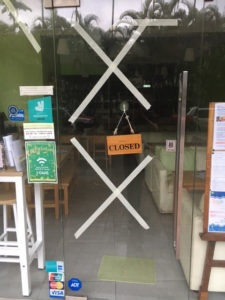
Like everyone else, I’m watching the news as Hurricane Harvey reaches category four intensity tonight. It will reach the coast of Texas around midnight, August 25th. My thoughts are with everyone in the affected region. I also hope that people are paying much closer attention to the news than I was when Typhoon Hato reached Hong Kong this Wednesday. I was staying at a hotel in Hong Kong, and was not following events, because I had been busy traveling back from Shenzhen. When I awoke in the morning I was surprised to see the rain coming down in buckets, but just thought it was a summer storm. I then went down the stairs, only to find myself confused by the shutters that had been installed on the main lobby doors at the Metropark Hotel. I went out another door, and was puzzled to see the sidewalks without pedestrians, the streets without cars, and businesses closed. When I saw that the windows up and down the street were taped with X’s, I realized what was happening.
Typhoon Hato skirted Hong Kong but hit Macau hard. Still, even in Hong Kong it was an impressive sight from the hotel’s rooftop. A burst of intense wind would pass through, whipping the palm trees back and forth. Clouds of leaves would hurl through the air, as they were sucked hundreds of feet into the sky. The rain would pour sideways. Then, I don’t know why, suddenly it would be dead calm. At one point I found myself watching a flock of birds, desperately trying to fly into the wind to avoid being sucked up into the hills. They would gain a little space, they be blown helplessly back. By late afternoon the worst was over, although heavy rains continued for hours.

I was amazed by how quickly Hong Kong recovered from the disaster, and how well-prepared the city was for such an event. Even though the airport was shut down on Wednesday, I was able to fly out on Thursday afternoon with no disruption. On the way to the airport, I could see city work crews dealing with a downed tree. The city has not parsed words when warning about the impacts of a typhoon. The “subways” in Hong Kong, which are underground passages beneath streets, have large signs showing people struggling in the waters, as part of an education campaign to warn people not to enter them during typhoons. Such planning saves lives.
Now Hurricane Harvey is on track to hit near Corpus Christi, and then to linger in the area for days afterwards. Given that the hurricane will continue to be strengthened over the Gulf waters the rainfall forecasts in some

areas will be measured in feet not inches. Eric Holthaus has a great article in Wired, “Hurricane Harvey heads for Texas Fracking’s Favorite Port,” which talks about how vulnerable refineries in this region are to a flooding event. Much of Corpus Christi’s infrastructure is only a few feet above sea level. Many of the refineries are vulnerable to flooding, and storage tanks may begin to float during a storm. It was just this issue that the podcast Reveal covered in a report about Houston in March 2016, titled “Mighty Ike: A monster storm in the making.” The detailed report looks at what happened with Hurricane Katrina, then interviewed different stakeholders and experts about what would take place with a similar event in Houston. I strongly recommend the podcast, as well as the associated storyboard by Propublica and the Texas Tribune, “Hell and High Water,” which looks at why Texas is not ready for such as storm. The opening maps are brilliantly done, and showed what might have happened with Hurricane Ike.
It’s human nature not to want to think about disasters in the future, or to expend funds and energy before a crisis. The situation is certainly the same in Portland, where the sewers and water system might not work for a year after a major earthquake hits. I recently talked about the difficulty of disaster planning in the context of Tampa, Florida, which faces a threat both from hurricanes and sea level. I hope that all cities that face an inevitable disaster in their future -whether an earthquake in Vancouver or Seattle, or a hurricane in Houston- can find the focus and will to do the sustained work required before the big one arrives. I also hope that people have heeded evacuation warnings in Texas, and that the hurricane will prove less severe than forecasts suggest.
Shawn Smallman, 2017.
